Sony α7
With the Sony α7 series Sony began to focus its Sony α system away from cameras with Minolta AF mount to mirrorless CSC cameras with Sony E-mount. The α7 series got the FE-mount variant which supports the new full-frame E-mount lenses. Thus the α7 where Sony's first CSCs with 35mm full-frame image sensor. With the Sony α7 II the move of the system's focus was finished by adding a 5-axis sensor shift, making it the first E-mount camera with anti-shake mechanism, a superior one compared to the "super steady shot" of the A-mount DSLRs and SLTs.
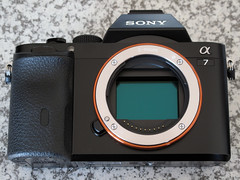  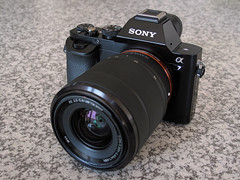
|
| Sony α7 CSC with Sony FE 3.5-5.6/28-70mm kit lens images by Hiroshi Uzu (Image rights) |
Sony α7
The Sony α7 was the quantum leap in digital photography, by having made a compact mirrorless digital system camera (CSC) capable to shoot "full format" what means a digital frame format equal to the quite ideal former miniature format, better known as 35mm film 24×36mm frame format. Before the α7's launch in 2013 this format was only available in bulky DSLRs, in professional camcorders and in the expensive Leica M9. The CSC has a full format Sony CMOS 24 megapixel image sensor, and a built-in electronic viewfinder. Its retro style housing resembles a Minolta XE. Thus Sony finally embraced the Minolta legacy that it represents since it took over all system camera production assets of Konica Minolta in 2006.
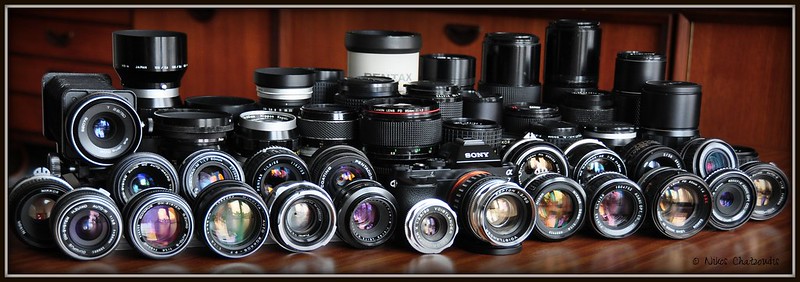
|
| The Sony α7's Sony E-mount = "All you can adapt ..." ;-)) image by Nik Chatou (Image rights) |
Sony α7R
The more expensive variant Sony α7R has a 36 megapixel full format sensor instead, thus being the first non-DSLR system camera offering this high image resolution. Drawbacks compared to A7 include lack of PDAF and EFCS.
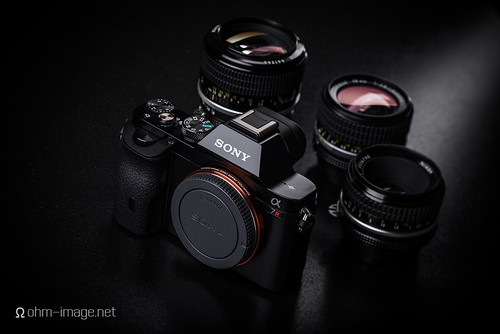
|
| α7R, alike the Sony NEX again a dream for lens adaptions image by Nathan Wright (Image rights) |

|
| Sony α7S with fast lens - almost a night-vision device image by Ronan Collett (Image rights) |
Sony α7S
The variant Sony α7S has a 12 megapixel full format sensor and 4K-video-format support. With less but larger pixels it is the low-light queen of Sony's cameras, allowing to shoot autofocus exposures and videos in almost dark places. The low-light advantage for stills is not as much as for video. Camera requires external HDMI recorder for 4k videos, it cannot write 4k on SD card. It is the first E-mount camera to feature full-metal mount with no plastics inside. It is the first E-mount to feature "silent mode" electronic shutter where focal plane shutter doesn't fire at expense of greater time parallax (and flash cannot be used).
Sony α7 II
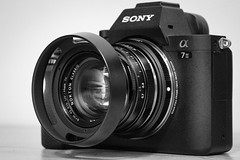
|
| Sony α7 II with Nokton "classic" lens image by Marcel Mendoza (Image rights) |
The Sony α7, but mightily reworked, for example with tiltable monitor instead of a fixed one. Thus it's not as light and slim as the 1st version. Long expected and finally delivered was the anti-shake mechanism, a 5-axis sensor-shift system. This camera gave the impulse to force other camera makers making small format (called full format in digital age) mirrorless digital system cameras (CSCs) since Sony could launch the 2nd α7 series very soon, thus proving the marketability of this camera class.

|
| α7 Mark II at sunset image by Falcon Photography (Image rights) |

|
| α7R II with 55mm f1.8 image by hej_pk (Image rights) |
Sony α7R II
The most expensive variant Sony α7R II of mid-2015 has a 42 megapixel full format sensor instead, again the first non-DSLR system camera with such an image resolution. Like the αA7 II it also got the sensor-position-stabilizing anti shake mechanism, a feature that all Sony DSLRs and SLTs had inherited from Konica Minolta'a DSLR, but Sony omitted the feature in the the whole Sony NEX camera series and in the succeeding Sony α cameras for E-mount. The α7R II got a state-of-art 5-axis anti shake, a technology similar to such of Olympus, but different in implementation. It also supports using PDAF with adapted lenses, so it can focus efficiently with A-mount lenses via LA-EA3 adapter and Canon lenses with third party adaptors (most of third party adapters emulate LA-EA3 instead of native lenses) and some others. A7R II is the first E-mount camera which can not only charge via USB, but operate from it.
Sony α7S II
The α7S II gets most of same improvements seen in R II, but it has same sensor as A7S, 12 MP non-BSI sensor without PDAF. Unlike R II, S II cannot write 4k video from APS-C frame because it does not have enough pixels.
Links
- Sony α7 α7R user manual at Manualslib
- Power consumption measurements for α7 with SEL2870 lens (Russian-language forum, and requiring Javascript)
| Japan Camera Grand Prix | |
|---|---|
| Camera of the year
1984: Nikon FA | 1985: Minolta α-7000 | 1986: Canon T90 | 1987: Canon EOS 650 | 1988: Kyocera Samurai | 1989: Nikon F4 | 1990: Canon EOS 10 | 1991: Contax RTS III | 1992: Pentax Z-1 | 1993: Canon EOS 5 | 1994: Minolta α-707si | 1995: Contax G1 | 1996: Minolta TC-1 | 1997: Nikon F5 | 1998: Pentax 645N | 1999: Minolta α-9 | 2000: Canon EOS-1V | 2001: Minolta α-7 | 2002: Canon EOS-1D | 2003: Canon EOS-1Ds | 2004: Nikon D70 | 2005: Konica Minolta α-7 Digital | 2006: Nikon D200 | 2007: Pentax K10D | 2008: Nikon D3 | 2009: Canon EOS 5D Mark II | 2010: Olympus Pen E-P1 | 2011: Pentax 645D | 2012: Nikon D800 | 2013: Sony DSC-RX1 | 2014: Nikon Df | 2015: Canon EOS 7D Mark II | 2016: Sony α7R II | 2017: Olympus OM-D E-M1 Mark II | 2018: Sony α9 | 2019: Lumix S1R | 2020: Sony α7R IV | 2021: Sony α1 | 2022: Nikon Z9 | 2023: Sony α7R V Special Prize Editor | |